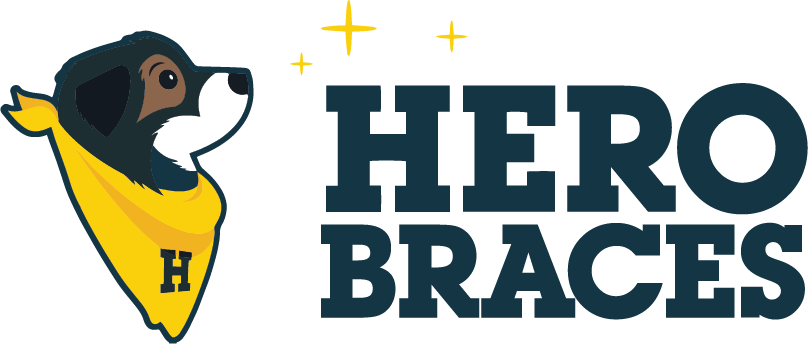Dog Bracing Made Simple
Tips and tricks to help your dog succeed with added support

Dog Bracing Made Simple
The Casting/Impression, “As easy as Wrapping a Bandage?!”
Does the Custom Orthotic Casting Process Intimidate You?
If you really think about it, the impression process isn't much different than wrapping a bandage. We find vet nurses excel at the process in the CE courses we teach! Check out a video of our CE course at the bottom of this blog.
Old-School Casts....Don't Make Me Cringe!
Many Doctors are hesitant to work with Orthotics because of the Casting/Impression process. Mention the word “cast” and Doctors envision an old-fashioned plaster cast that is removed with a saw.
This material was fine in its day but today is not needed for the Impression process. The fiberglass impression material currently used is easier to work with and does not require a saw for removal.
Creating a dog’s custom knee, ankle or wrist brace is a breeze. Hero Braces has tried to simplify the process to make successful impressions a breeze.
As easy as wrapping a bandage.
Creating the Impression for a custom brace is an easy task. As practitioners, bandages are something we use daily. The light tension and 50% overlap used in creating a bandage are the same when creating an Impression. Patients can lie in lateral recumbency and staff use is the same. Sedation is rarely needed. The fiberglass material used in the Impression is thin and cuts easily once it cures.
I don’t have time.
We all worry about the time it takes to get tasks done. The Impression process can take as little as 15 mins. Many practices have qualified Veterinary Nurses that place bandages for their Doctors every day. The Casting/Impression can be turned over to them as well, freeing up the Doctor to diagnose and prescribe Hero Braces as treatment for issues such as Cranial Cruciate Ligament Rupture, Hyperextension of the Carpus and Achilles Tendon Injuries.
We’ve got the tools you need.
Our impression kit comes with everything you need to complete the process and we are here to help.
Stockinette to cover and protect the limb
Fiberglass tape to create the impression
A guarded blade knife to cut the Casting/Impression tape
A grooved strip to place under the Casting/Impression tape to guard the limb and act as a cutting guide
Online and in person labs to demonstrate and practice the process
Anything new can be intimidating. The Casting/Impression uses similar techniques to wrapping a bandage and is learned quickly by you and your staff. Let us help you help more pets. Call Hero Braces for a Casting/Impression kit today.
We teach casting at the University of Tennessee Canine Rehab Certificate Course. Below is a video of us teaching the casting process. Watch it to feel confident about casting. It really is just a version of bandaging!

Dog Bracing Made Simple
4 Tips - The Perfect Dog Brace Cast
Creating the perfect Casting can be summed up in four essential tips.
Position. Tight. High. Criss-Cross. Understand each to make yourself the Casting superstar for Custom Orthotics!
Let’s be clear on what “Casting” means in this article. Old school casts meant a kid with a broken arm had white plaster wrapped from elbow to wrist. These aren’t your old school casts!
The word “Cast or Casting” is used because it sounds like “cast.” The material is fiberglass casting tape, used to make an impression of the limb.
Position - The "Magic" of Walking Easily
This is where Hero Dog Braces really differ from other custom bracing. We ask for a cast with the dog lying on its side instead of standing.
This is important for a couple of reasons.
First is gravity. Gravity is really what feeds any deformity. The body weight pushes down on the legs, worsening the deformity. Casting a dog while lying down neutralizes gravity, allowing you to focus on getting the limb into the corrected position.
Second is rational. Can you really get a dog to stand still for 15 minutes while the cast sets? Much less "correct" the leg while doing this. In our vet clinic, our team holds the dog to trim its nails. Casting is no different.
So how do we correct the position? It is important to remember what deformity we are trying to support. The cranial drawer of a cruciate tear is a unique motion. We reduce it differently from angular deformities like varus or valgus.
When casting for the Knee Brace, pull the leg straight down perpendicular to the body. This will reduce the cranial drawer. Trying to cast in a “natural” standing position can cause the tibia to shift forward and adversely affect the fit and function of the custom orthotic.
For the Ankle Brace, place the foot and ankle in a natural standing position.
The Wrist Brace reduces any varus (foot angled towards midline) or valgus (foot angled away from midline) deformity and places the foot in a natural standing angle. Typically, the pet is straight through the wrist, but it can vary with breed. If this one is confusing, give us a call, and we can help guide you through the process.
Tight - Show us the Boney Landmarks
A Tight Casting is necessary for precision work. When the Hero Braces lab has exact dimensions taken from the Casting, they can create the best custom fit.
The Casting tape should be wrapped snugly to outline the bony prominences or bumps on the leg. If the Casting tape does not have sufficient tension, it will droop and fail to outline the prominences. This creates guesswork for the lab or necessitates another Cast.
Remember, no padding is added, just a layer of stockinette to protect the limb. This keeps the Cast true to the leg's shape. Because the Cast will be removed as soon as it hardens, you don’t need to worry about pressure points.
High - Capture the Groin
For the stifle, make sure the protective stockinette goes high into the groin or beyond the area to be cast. This is really important to have your helper focus on keeping the stockinette high. Notice where the hands are; it really helps to pull the stockinette high in the inside of the leg.
When starting the Cast, casting tape is spiraled up the leg with a 50% overlap. The Casting tape wraps high into the groin for Custom Dog Knee Braces or to the joint above for the Wrist and Ankle Braces. Be sure to wrap to the end of the foot for our Custom Wrist and Ankle Braces.
This technique enables the Hero Brace lab to identify landmarks, take measurements, and plan the proper dimensions of the Custom Brace.
Criss-Cross - Make it Strong AND Thin
This tip will make you happy when it comes time to cut off the cast. A thin cast is so much easier to cut through.
A 50% overlap of the Casting material wrapped around the limb is completed by spiraling down at a 45-degree angle, like the spiral on a candy cane. Criss-crossing the material's weave creates a strong yet light Cast. The three layers created are thin enough to be cut off easily, yet they stay together during shipping and at the lab.
For reference, download our Casting Tips PDF.
For a more in-depth video about casting. Watch our course from the UT Canine Rehab Lab
If you have any questions or need a little help, we are here to support you. Make a quick phone call or send us an email.
Hero Braces want to help you help more pets.






